
The Solar-Terrestrial Centre of Excellence (STCE) is a collaborative network of the Belgian Institute for Space Aeronomy, the Royal Observatory of Belgium and the Royal Meteorological Institute of Belgium.
 |
Published by the STCE - this issue : 31 Oct 2014. The Solar-Terrestrial Centre of Excellence (STCE) is a collaborative network of the Belgian Institute for Space Aeronomy, the Royal Observatory of Belgium and the Royal Meteorological Institute of Belgium. |
| Archive of the newsletters | Subscribe to this newsletter by mail |
Much has already been written on the numerous X-class flares produced by NOAA 2192. In this news item, scientists from the STCE let their light shine on some of the other issues associated to this very active region:
- How does NOAA 2192 compare in size to other sunspot groups?
- How "old" is NOAA 2192?
- How exceptionnal was NOAA 2192's flaring activity?
- Why were there no obvious CMEs associated to these X-class flares?
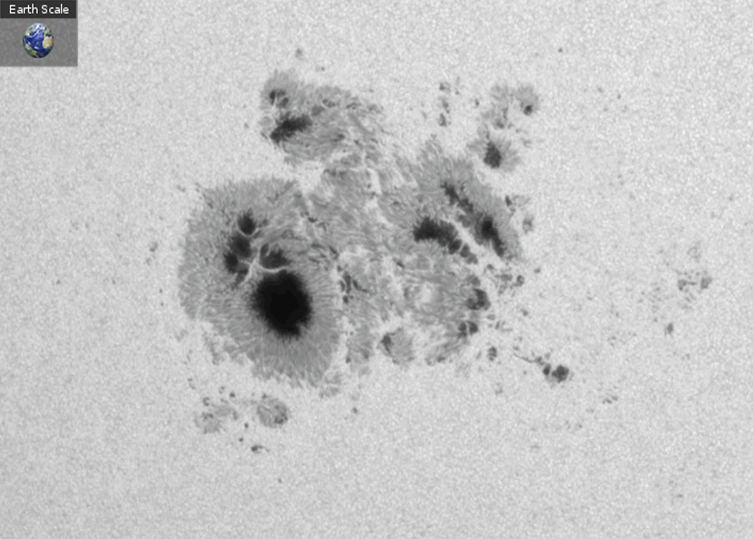
According to the NOAA reports, NOAA 2192 reached a maximum sunspot area of 2750MH (see Note 1) on 26 October. This is comparable to 16 times the Earth's surface area. It is by far the biggest sunspot group of the current solar cycle, and even slightly bigger than the famous Halloween group NOAA 0486 (see Note 2), the largest sunspot region of the previous solar cycle (2610MH). We have to go back already to November 1990 to find the first region which was even bigger (NOAA 6368, 3080MH)!
NOAA 2192 currently ranks 12th in the Top-50 of largest sunspot groups observed since 1874. See http://users.telenet.be/j.janssens/Engzonnecyclus.html#Top50spot for an overview. The largest group appears to have been Greenwich 1488603 which started its transit of the solar disk late March 1947 and reached its maximum sunspot area on 8 April 1947. There are drawings of this sunspot group in the archives of the Kanzelhöhe Solar Observatory at http://cesar.kso.ac.at/synoptic/draw_days.php?year=1947 Amazingly, almost the entire NOAA 2192 group would fit in just the main spot of Greenwich 1488603! See image underneath for a comparison.
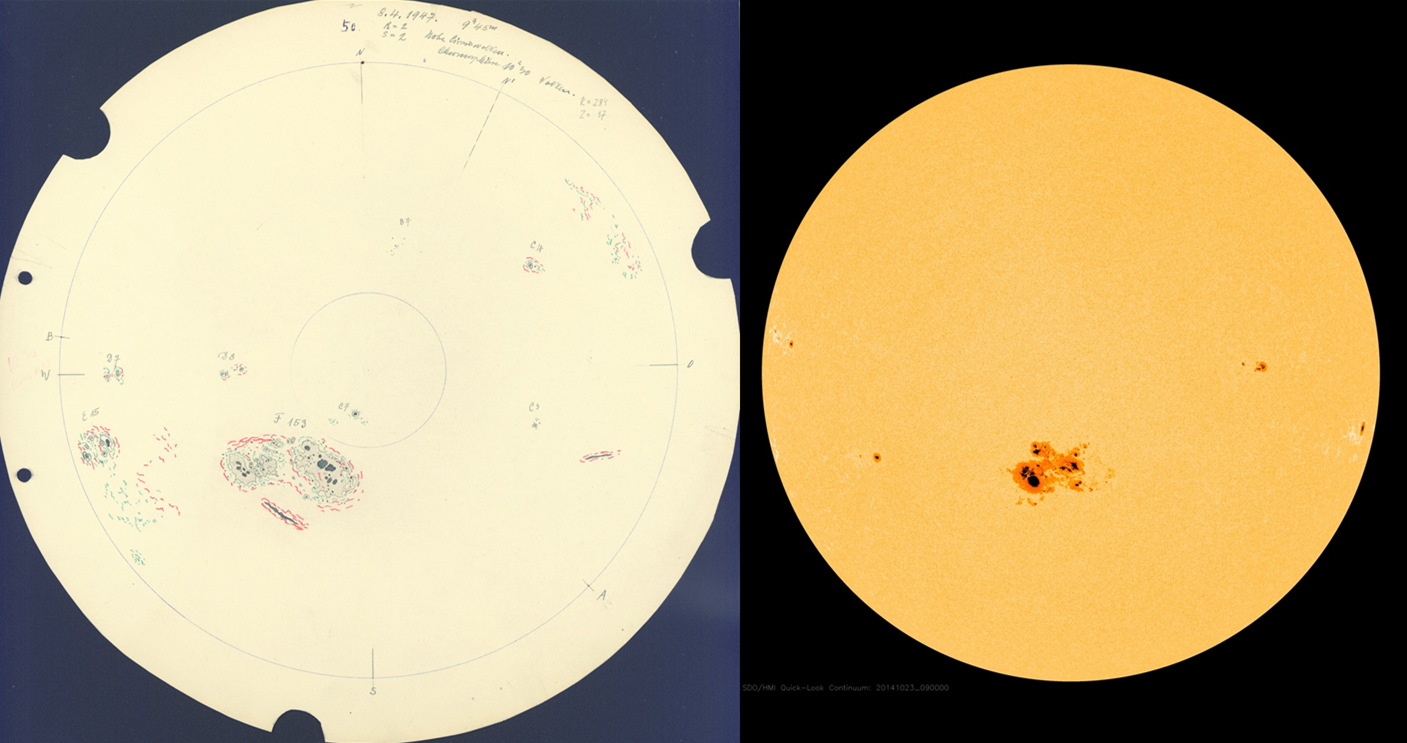
It is well known that big sunspot groups can survive for several solar rotations. So, it didn't take long before the blogs were speculating on the number of solar rotations NOAA 2192 had already survived. Some of them were going back till June this year, making NOAA 2192 almost 5 months old!
So, a preliminary analysis was performed of the positions and evolution of the sunspot groups that have appeared in this area starting June this year. As it turns out, most of these groups appeared several degrees to the north or the south of NOAA 2192. More importantly, quite a bit of these groups were decaying. This was for example the case early August when the groups NOAA 2127-2131 were rounding the west limb, and the entire area was nearly devoid of sunspots.
An STCE scientist concludes: "... Indeed, I only see one possible recurrence. There was already a big active region complex (NOAA 2172-2173) at that longitude one month ago, crossing the central meridian on 26 September. However, both active regions were decaying and were about to vanish when passing the west solar limb. Therefore, it may well be that this is the first appearance of NOAA 2192. ..."
He adds that "... Let us keep in mind that the past months marked a high peak in the current cycle, possibly the actual cycle maximum. For an active Sun, there is then always a rather large probability that an active region appears in any longitude "bin" simply because of the high overall density of active regions. ... Therefore, in my sense, all earlier cases before September are obviously due to the random location of emerging active regions."
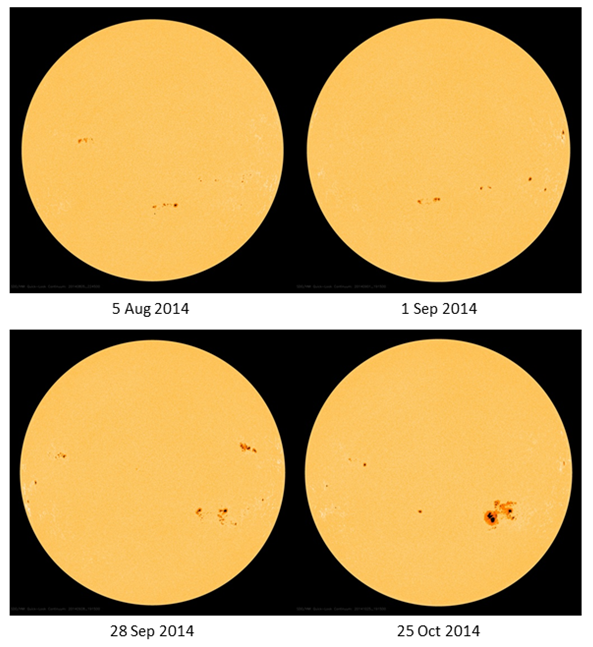
NOAA 2192 has produced already 6 X-class flares, and it has not rounded the west solar limb yet. Since systematic solar x-ray observations started in 1976, about 12000 groups have appeared on the solar disk and got a NOAA-number. Yet, only 13 of those sunspot groups managed to produce 6 or more X-class flares during their transit.
The table below shows this "wild bunch". NOAA 5395 (March 1989) and NOAA 0808 (September 2005) are well-known for their high number and particularly intense solar flares. Interesting is that there are a few groups with a relatively small area that also produced 6 X-class flares, such as NOAA 0649 (July 2004). It's also true that big groups not necessarily produce the most or the most intense X-class flares.
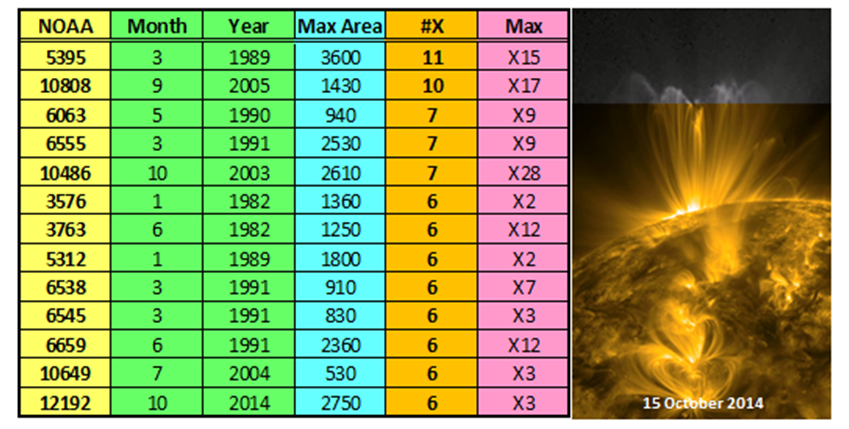
THE question of the week was probably why there were no obvious coronal mass ejections (CMEs) associated to all the X-class flares produced by NOAA 2192. Except for the brief HF radio black-outs resulting from the intense x-ray radiation, space weather forcasters were puzzled by the lack of geo-effective effects (no increase in high-energetic particles, no CMEs).
However, scientists of the STCE pointed out that "... Flares and CMEs are both consequences of a restructuring of the magnetic field in the corona. But there are no requirements that both signatures are present. ..." meaning that "... There's nothing in particular that says large flares need to be associated with CMEs. Any large magnetic reconnection event that frees stored ... energy can make a large flare, but the active region is not always in a favorable configuration to produce an eruption. ..."
In the case of NOAA 2192, "... This region appears to be dominated by very strong magnetic fields, which accounts for the strength of the flaring, but does not contain large, unstable prominences. So you can get the interaction of powerful fields and, thus, big flares without freeing a lot of built up field and plasma to erupt. ..." In particular, "... this region's magnetic configuration was close to bipolar on the large scale. So, though it was classified as beta-gamma-delta (see Note 3), the mixed polarities were small and not affecting too much the large-scale magnetic field above the photosphere. ..."
In conclusion, statistically, a big flare is usually associated to a CME, but it is certainly not physically required to have both together. In fact, "... confined X-class flares are not that uncommon (for one reason or another). What is uncommon is such a remarkable series of strong flares without a clear CME. ..." Peculiar cases like these perfectly illustrate the fact that there are still significant gaps in our understanding of the generation of CMEs and in predicting space weather in general.
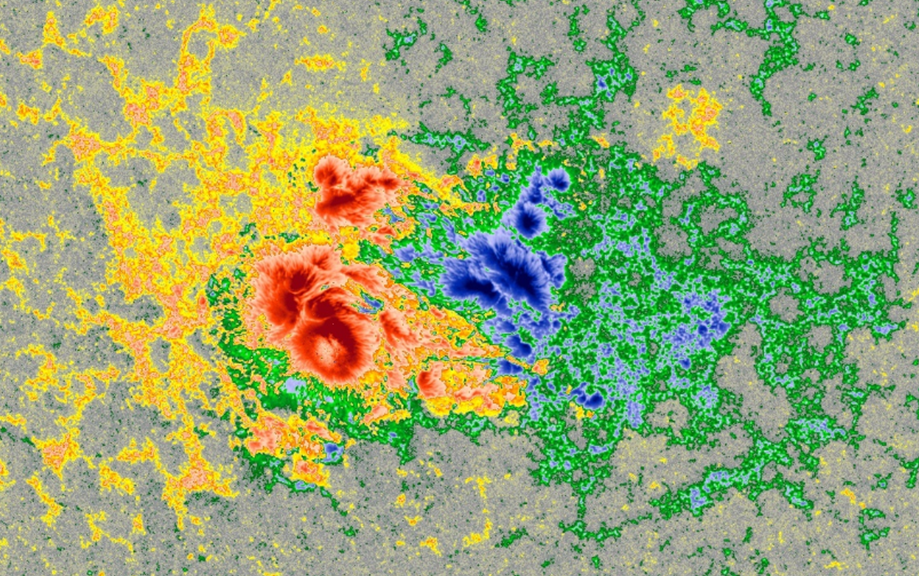
Note 1 - MH: Millionths of a solar hemisphere, with 1MH corresponding to about 3 million km2. The total area of the Earth corresponds to about 167MH, which is a good reference when comparing big sunspot groups.
Note 2 - The NOAA numbering started in 1972, with currently more than 12000 sunspot groups numbered. Starting from group 10000, it is not uncommon to omit the first "1". Hence, in this text e.g. NOAA 0486 is used instead of NOAA 10486.
Note 3 - More on Beta-Gamma-Delta in this news item at http://stce.be/news/222/welcome.html
Credits - Data and imagery were taken from NOAA/SWPC (http://www.swpc.noaa.gov/today.html), NASA/MSFC (http://solarscience.msfc.nasa.gov/greenwch.shtml), SDO (http://sdo.gsfc.nasa.gov/data/aiahmi/), PROBA2 (http://proba2.oma.be/ssa), and Kanzelhöhe Observatory (http://cesar.kso.ac.at/).
Nine sunspot groups were reported by NOAA during the week, with NOAA AR numbers 2186, 2187, 2191, 2192, 2193, 2194, 2195, 2196, and 2197. NOAA AR 2192 (Catania number 88) grew to become the biggest sunspot group during two solar cycles (since 1990) and produced the most of the solar activity during the week. This included four X-class flares, fourteen M-class flares, and numerous C-class flares. The only M-class flare produced by another region was the east-limb M1.4 flare peaking at 15:57 UT on October 22 in the future NOAA AR 2197.
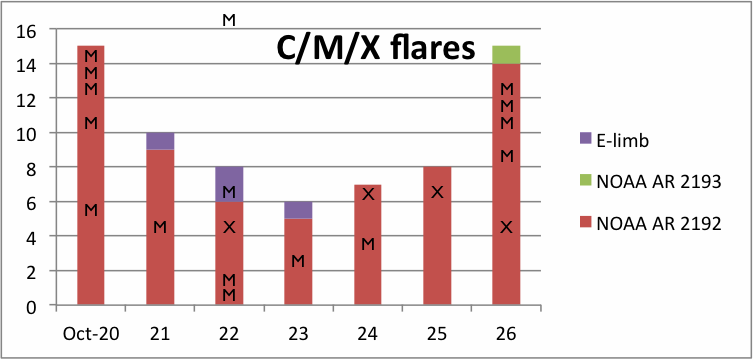
The strongest flare of the week was the X3.1 flare peaking at 21:41 UT on October 24. Most of the flares in the NOAA AR 2192 were either confined (and not accompanied by a CME) or associated with weak and/or narrow CMEs that did not arrive at the Earth. The only exception was the M1.4 flare peaking at 19:02 UT on October 20. It was associated with a weak partial halo CME (angular width around 200 degrees) first seen in the SOHO/LASCO C2 field of view at 19:12 UT. The CME was very weak and disappeared before reaching the LASCO C3 field of view, so it did not arrive at the Earth.
The solar proton flux remained at the background level during the week.
On October 20 the Earth was situated inside an interaction region between slow and fast solar wind flows. Due to elevated values of the interplanetary magnetic field (IMF) magnitude and predominantly southward IMF direction, the K index reached 5 during one interval in the evening of October 20 (according to Dourbes, IZMIRAN, and NOAA). On October 21 the fast flow arrived, and the geomagnetic conditions were quiet to active. The fast flow was associated with a narrow low-latitude coronal hole that passed the solar central meridian on October 17-18.
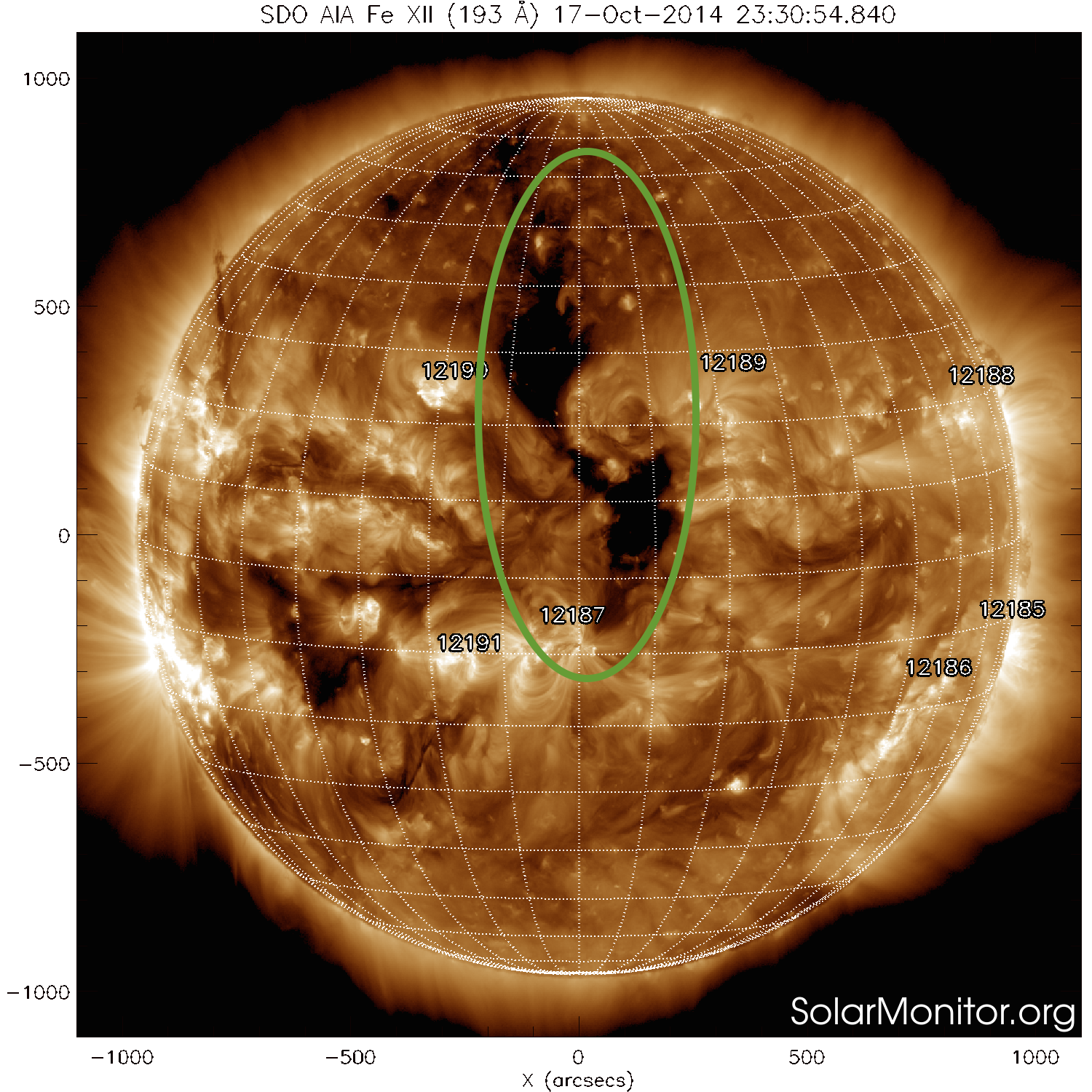
On October 22 the fast stream ended, and slow solar wind was observed until the end of the week. Several occasional intervals of active (K = 4) geomagnetic conditions were reported (IZMIRAN even reported one minor storm interval of K = 5 on October 22), but overall the geomagnetic conditions were quiet to unsettled.
| DAY | BEGIN | MAX | END | LOC | XRAY | OP | 10CM | TYPE | Cat | NOAA |
| 20 | 0900 | 0911 | 0920 | S14E42 | M3.9 | 1N | 47 | 88 | 2192 | |
| 20 | 1600 | 1637 | 1655 | S14E37 | M4.5 | 2N | 190 | 88 | 2192 | |
| 20 | 1855 | 1902 | 1904 | M1.4 | 120 | 88 | 2192 | |||
| 20 | 1953 | 2004 | 2013 | M1.7 | 88 | 2192 | ||||
| 20 | 2243 | 2255 | 2313 | S14E36 | M1.2 | 1N | 88 | 2192 | ||
| 21 | 1335 | 1338 | 1340 | M1.2 | 510 | III/2II/2 | ||||
| 22 | 0116 | 0159 | 0228 | M8.7 | 580 | IV/1 | 88 | 2192 | ||
| 22 | 0511 | 0517 | 0521 | M2.7 | 88 | 2192 | ||||
| 22 | 1402 | 1428 | 1450 | S14E13 | X1.6 | 2B | 200 | 88 | 2192 | |
| 22 | 1551 | 1557 | 1603 | M1.4 | II/1 | |||||
| 23 | 0944 | 0950 | 0956 | S16E3 | M1.1 | 1F | 88 | 2192 | ||
| 24 | 0737 | 0748 | 0753 | M4.0 | 150 | V/2II/1IV/1 | 88 | 2192 | ||
| 24 | 2107 | 2141 | 2213 | S16W21 | X3.1 | 3B | 210 | 88 | 2192 | |
| 25 | 1655 | 1708 | 1811 | S16W31 | X1.0 | 3B | 160 | 88 | 2192 | |
| 26 | 1004 | 1056 | 1118 | S18W40 | X2.0 | 2B | 200 | 88 | 2192 | |
| 26 | 1708 | 1717 | 1730 | M1.0 | 110 | 88 | 2192 | |||
| 26 | 1807 | 1815 | 1820 | M4.2 | 88 | 2192 | ||||
| 26 | 1843 | 1849 | 1856 | M1.9 | 88 | 2192 | ||||
| 26 | 1959 | 2021 | 2045 | M2.4 | III/2 | 88 | 2192 |
| LOC: approximate heliographic location | TYPE: radio burst type |
| XRAY: X-ray flare class | Cat: Catania sunspot group number |
| OP: optical flare class | NOAA: NOAA active region number |
| 10CM: peak 10 cm radio flux |
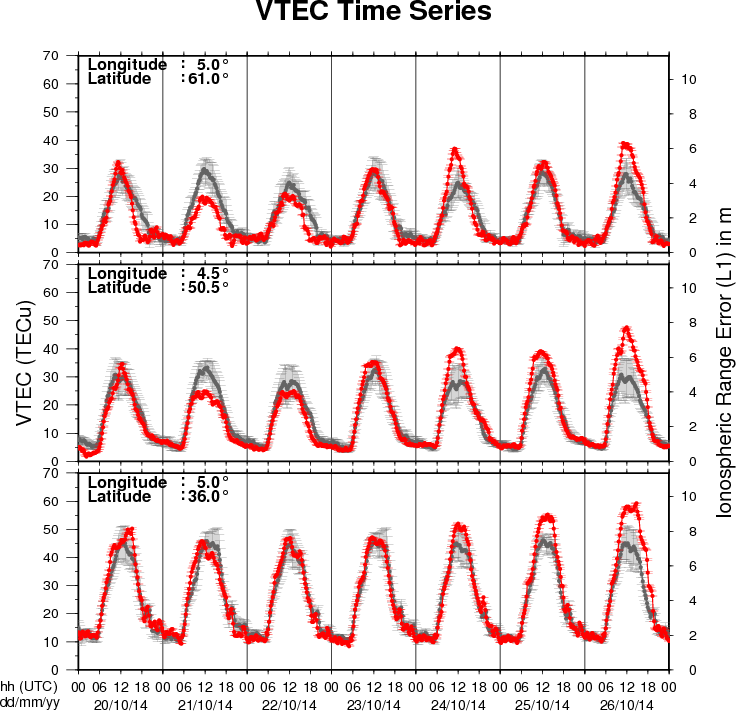
The figure shows the time evolution of the Vertical Total Electron Content (VTEC) (in red) during the last week at three locations:
a) in the northern part of Europe(N61°, 5°E)
b) above Brussels(N50.5°, 4.5°E)
c) in the southern part of Europe(N36°, 5°E)
This figure also shows (in grey) the normal ionospheric behaviour expected based on the median VTEC from the 15 previous days.
The VTEC is expressed in TECu (with TECu=10^16 electrons per square meter) and is directly related to the signal propagation delay due to the ionosphere (in figure: delay on GPS L1 frequency).
The Sun's radiation ionizes the Earth's upper atmosphere, the ionosphere, located from about 60km to 1000km above the Earth's surface.The ionization process in the ionosphere produces ions and free electrons. These electrons perturb the propagation of the GNSS (Global Navigation Satellite System) signals by inducing a so-called ionospheric delay.
See http://stce.be/newsletter/GNSS_final.pdf for some more explanations ; for detailed information, see http://gnss.be/ionosphere_tutorial.php
Start : 2014-11-12
This conference aims to bring together researchers, engineers,
users in the area of Big Data in the Space sector.
The focus is on the whole data lifecycle, ranging from data
acquisition by spaceborne and ground-based sensors to data
management, analysis and exploitation in the domains of Earth
Observation, Space Science, Space Engineering, Space Weather,
etc.
Special emphasis will be put on highlighting synergies and
cross-fertilization opportunities from domains like Climate Change,
Solid Earth Science, Planetary Sciences, Life Science,
Astrophysics, High Energy Physics, Social Sciences, etc.
We expect this conference to:
* contribute towards a common "Big Data from Space" scientific
and programmatic framework
* widen competences and expertise of universities, labs and
industrial actors
* foster networking of experts and users towards better access
and sharing of data, tools and resources
* leverage innovation, spin-in, spin off of technologies, and
business development arising from research and industry
progress
Website:
http://congrexprojects.com/2014-events/BigDatafromSpace/objectives
Start : 2014-11-17 - End : 2014-11-21
The 11th Edition of the European Space Weather Week will take
place on 17-21nd November 2014 in Liège, Belgium.
The ESWW will again adopt the central aim of bringing together
the diverse groups in Europe working on different aspects of Space
Weather. This includes but isn't limited to the scientific
community, the engineering community, applications developers,
service providers and service end users.
The meeting organisation is coordinated by the Belgian
Solar-Terrestrial Centre of Excellence (STCE), ESA and the Space
Weather Working Team. The local organisation is done by the
STCE.
Website:
http://www.stce.be/esww11/
Start : 2014-12-15 - End : 2014-12-19
Join nearly 24,000 Earth and space scientists, educators,
students, and other leaders in San Francisco, California, 15-19
December, as they gather to present groundbreaking research and
connect with colleagues. The abstract submission site is now
closed. The housing and registration tools are now open;
pre-registration deadline: 14 November, 11:59 P.M. EST. Note:
letters of notification regarding abstract submissions have now
been electronically distributed.
Website:
http://fallmeeting.agu.org/2014/
Start : 2014-12-15 - End : 2014-12-19
The AGU Fall Meeting is the largest worldwide conference in the
geophysical sciences, attracting more than 22,000 Earth and space
scientists, educators, students, and other leaders. For 46 years,
energized and passionate Earth and space scientists from around the
world gather at the AGU Fall Meeting to connect with colleagues,
broaden their knowledge base, and embrace the joy of science. The
2014 meeting takes place Monday 15 - Friday 19 December 2014.
Several sessions about space weather are foreseen:
*
When and Why Does Space weather Forecasting Fail?
*
Addressing Operational Space Weather Needs
*
Near Real Time Data for Earth Science and Space Weather
Applications
*
Understanding Hemispheric Asymmetry and Space Weather
*
Connection of Solar Events With the Variability of Space
Environments
*
Bz from the Sun to the Earth: Observations and Modeling
*
Solar Sources and Heliospheric Consequences of Coronal Mass
Ejections in Solar Cycle 24
*
Advances in Ionospheric Forecasting - Modeling, Observations, and
Validation
Abstract Submission Deadline: August 6, 2014
Website:
http://fallmeeting.agu.org/2014/
Start : 2015-04-12 - End : 2015-04-17
The EGU General Assembly 2015 will bring together geoscientists
from all over the world to one meeting covering all disciplines of
the Earth, planetary and space sciences. The EGU aims to provide a
forum where scientists, especially early career researchers, can
present their work and discuss their ideas with experts in all
fields of geoscience. The EGU is looking forward to cordially
welcoming you in Vienna!
Website:
http://www.egu2015.eu/
Start : 2015-04-20 - End : 2015-04-24
This gathering was born out of the desire to collect in one
place the latest technologies required for advancement of science
in the discipline of Solar and Space Physics. In doing so, it was
recognized that the two 1998 volumes of 'Measurement Techniques in
Space Plasmas' (Particles and Fields) have been a valuable
reference and resource for advanced students and scientists who
wish to know the fundamentals of measurement techniques and
technology.
Website:
https://mtssp.msfc.nasa.gov/
Start : 2015-06-22 - End : 2015-07-02
We invite contributions on novel inversion methods with
application across the geosciences. Of particular interest are 3D
imaging, joint inversion of geodetic, geophysical and geochemical
datasets, and multi-disciplinary interpretation approaches such as
integration of gravity, EM and seismic data or thermo-mechanical
modelling studies constrained by physical parameters.
Modelling of Space Weather Effects: Solar, Magnetospheric and
Earth Resistivity Constraints (IAGA, IAMAS)
In this symposium we welcome contributions on all aspects of the
modelling of space weather and its effects, from the Sun to Earth.
This includes the modelling of the various interactions between
travelling solar storms and the solar wind, magnetosphere,
ionosphere and solid Earth and the validation of models through
measurements. Contributions on models developed to aid end-users,
such as satellite and power grid operators, survive the impact of
space weather are also encouraged.
Website:
http://www.iugg2015prague.com/joint-inter-association-symposia.htm#JA
Presentation, in French given at the open doors of the Space Pole, Brussels, Belgium, 2014
http://www.spaceweather.eu/en/repository/show?id=542
Presentation, in Dutch given at the open doors of the Space Pole, Brussels, Belgium, 2013.
http://www.spaceweather.eu/en/repository/show?id=543
Presentation, in French given at the open doors of the Space Pole, Brussels, Belgium, 2014
http://www.spaceweather.eu/en/repository/show?id=544
Presentation, in French given at the open doors of the Space Pole, Brussels, Belgium, 2014
http://www.spaceweather.eu/en/repository/show?id=545
Presentation, in French given at the open doors of the Space Pole, Brussels, Belgium, 2014
http://www.spaceweather.eu/en/repository/show?id=546
Presentation, in Dutch given at the open doors of the Space Pole, Brussels, Belgium, 2014
http://www.spaceweather.eu/en/repository/show?id=547
Presentation, in French given at the open doors of the Space Pole, Brussels, Belgium, 2014
http://www.spaceweather.eu/en/repository/show?id=549
Presentation, in Dutch given at the open doors of the Space Pole, Brussels, Belgium, 2014
http://www.spaceweather.eu/en/repository/show?id=548
Presentation, in Dutch given at the open doors of the Space Pole, Brussels, Belgium, 2014
http://www.spaceweather.eu/en/repository/show?id=550
Presentation, in Dutch, given at the open doors of the Space Pole, Belgium, 2014
http://www.spaceweather.eu/en/repository/show?id=551
Presentation, in Dutch, given at the open doors of the Space Pole, Belgium, 2014
http://www.spaceweather.eu/en/repository/show?id=552